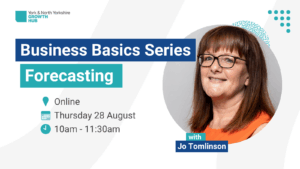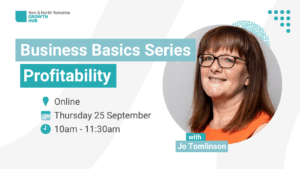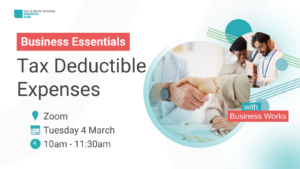Profitability
Profit is a measure of a business’s income relative to its expenses. In other words, an organisation’s ability to generate revenue by using resources that it has available, such as people, materials and equipment.
Unless you are running a charitable organisation, profit is generally the primary goal of a company. As well as providing income for the owners of a business, profits allow for investment and growth.
Whilst revenue growth is generally a positive indicator, we need to understand profitability if a business is to be successful.
Reporting
Timing
To maximise profit, we need to measure profit regularly. Monthly, rather than annually. Or on a project by project basis.
Lots of businesses don’t track profitability throughout the year, and only really see how profitable they have been once they get accounts back from their accountant. This could be 9 months, after the year has ended!
If we monitor profitability monthly, then we will get an early warning if things start to go awry.
By understanding what drives profitability, we can put in strategies to maximise it.
By measuring profitability regularly, we can put in mitigating strategies if things start to go off track. Early, so that we minimise the damage to the bottom line.
By income stream
If we understand the profitability of each of the products and services we are selling, as well as the profitability of the business as a whole, we use this information to drive our strategies to maximise profitability.
To do this we need to analyse our numbers, and to analyse our numbers, we need to ensure we capture the numbers we need when processing our data.
The mechanics
Revenue – COS > overheads = profit
Fundamentally, a business needs its revenues to be greater than its direct costs (gross profit), by enough to at least cover its overheads, for it to be profitable.
As a lot of businesses sales ramp up rapidly in the first three years or more, the gross profit on the lower sales in the first couple of years is often insufficient to cover overheads, hence the adage that small businesses make a loss in year one, break even in year two and make a profit in year 3. Of course you are not the average business, so you need to understand your business model properly and then work with that to maximise your profitability.
Gross Profit
Gross profit is the profit a business makes after deducting the direct costs associated with producing its goods or services, known as the cost of goods sold (COGS). Gross profit is calculated by subtracting COGS from total revenue. This figure provides a snapshot of profitability before considering other business expenses like operating costs, depreciation and interest.
COGS or direct costs are things like:
- Things that you buy to sell
- Things that you buy to convert into things that you sell
- The cost of converting things that you buy into things that you sell (like direct labour)
- Things that vary in line with the number of products or services that you create/sell
Some of the terminology around profitability can get confusing so here are a few other measures/terms and what they mean;
Gross Margin: the percentage version of gross profit.
Calculation: Take COGS away from Revenue to get Gross Profit and then divide this by revenue.
Example:
- Revenue £1,000
- COGS £500
- Gross Profit £500
- Gross Margin 50%
Markup – the difference between the cost of a product and its selling price, generally expressed as a percentage
Calculation: Take COGS away from Revenue and divide this by COGS.
Example:
- Revenue £1,000
- COGS £500
- Gross Profit £500
- Markup 100%
Net Profit
Net profit is the profit a business makes after deducting the direct costs and indirect costs (also known as overheads) associated with producing its goods or services from its revenue.
After a few year end adjustments, this will become the taxable profit of the business.
Indirect cost or overheads are things like:
- Premises related costs (rent, rates, utilities etc)
- Insurances
- Sales and Marketing
- Accountancy and other professional costs
- Any interest or other finance costs
- Staff costs, where these are not COGS (often managers and administrators), including training costs.
- Travel costs
- Phones and internet access etc
EBITDA is a term often used by financial services people. It’s mainly used in big businesses and stands for.
Earnings before interest, taxes, depreciation and amortization.
Whilst tax would never be included in net profit, interest and depreciation or amortization would be, although the later would generally be amended to capital allowances as part of the year end calculations done by your accountant.
Why Split Profits
We need to understand the profitability, not just of the whole business, but split by product or service, or groups of similar products and services. We need to split the profitability like this as all products and services do not make the same profit!
There are some products or services, that are niche, in short supply, highly sought after, perceived to be worth more for some reason, and you can charge more for these products or services. This is likely to mean that you also make a higher gross margin on them.
It’s not always possible to mark up all products or services as much as you would like. For example, offering milk alternatives in a coffee shop. These alternatives to cows milk are often much more expensive than your regular milk and you will probably also incur high waste levels.
Sometimes we need to sell lots of something before we can make even a gross margin on it, due to inefficiencies at lower volume levels or bulk discounts available once you are selling more. So, whilst the price you sell at, may make a healthy profit in the longer term, in the short term, it may not. How long can the business absorb these lower margins, or even losses and are you tracking them?
Sometimes, we don’t actually know that we have products or services that don’t make a gross profit unless we collect the data and do the analysis!
Analysis
Once you have collected the data giving you visibility of which products or services make what gross profit, what do you do with it?
- Consider interlink – are any products of services interlinked, in which case, you probably can’t remove one, without having a massive impact on the other
- Do any low profit generating products or services bring in customers/clients who also buy high margin items, and how can you ensure this happens
- Can you increase prices?
– Can you upsell
– Create bundles
– Use offer
– Use mid-tier pricing - Can you reduce costs?
Knowledge is power, and now you have clarity around which of your range makes what gross margin, you can put plans in place to do something about it – with your eyes wide open, nothing masked behind the overall profit position.
If you have a service business, is your margin on certain services being eroded by scope creep, where you end up delivering more than you included in the proposal?
Process
Rather than do this analysis as a one off, we should be tracking profit in this way all the time, so can you put in a process which:
- Provides a breakdown of the cost of each product that you can keep up to date?
– Track time
– Track materials usage
– Track wastage
- Review the profitability by product regularly
- Review pricing at least annually
Gross or Net Profit?
Direct costs are much easier to allocate to products/services than indirect costs, so in most cases, profitability analysis by product, will be to gross profit level only.
You can of course continue to the net profit level, but to do this you need to consider how to apportion overheads.
- Activity Based Costing (ABC) – this method of allocating overheads is arguably the most accurate, however, it is also the most time consuming, so you generally need to question whether the effort justifies the outcome. Using this method, costs are allocated by time, or space taken up, or machine time or a mixture, depending on the cost.
- Flat rate % – this method allocated a fixed % to each product/service. Often as a % of sales revenue.
As both of the above methods are flawed, lots of businesses will go with a hurdle gross margin % that is higher to take into account overheads.
Provided by Jo Tomlinson, Business Works.
Business Basics - Forecasting
Although we don’t have a crystal ball, so forecasts are fundamentally informed guesses, businesses need to use them to make informed business decisions and develop business strategies.
Profitability
Profit is a measure of a business’s income relative to its expenses. In other words, an organisation’s ability to generate revenue by using resources that it has available, such as people, materials and equipment. Unless you are running a charitable organisation, profit is generally the primary goal of a company. As well as providing income for the owners of a business, profits allow for investment and growth. Whilst revenue growth is generally a positive indicator, we need to understand profitability if a business is to be successful.
Business Essentials: What is a Tax Deductible Expense?
As a business owner, it can be daunting when you are trying to work out what you can and can’t claim as tax deductible expense. Other business owners will give you their opinion but is that the right advice for you and your business? You can search online, but this can be confusing and often contradictory. So, what can you claim?
Financial Management – Do you know your numbers?
One of the most important things a business owner should know, is “their numbers”. Do you know how well your business is performing and in which areas? Do you know who you owe and who owes you? Can you afford to make upcoming payments and meet your financial obligations?
Bookkeeping for Business Owners
Business owners often handle their own bookkeeping when they first start out, as they are time-rich but money poor. However, bookkeeping isn’t a skill you acquire simply by registering a business. But with a robust process, great software, a little training, and someone to call when you’re unsure, it is possible to do this well, even as a novice.
Pricing for Maximum Profit
Are you charging enough for your products or services to allow you to provide a service you are proud of and that allows you to not become a busy fool? Are you confident that you are charging the correct price for your goods or services?
Navigating the Latest Budget: A Survival Guide for Small to Medium Businesses
The Budget announced on October 30th will bring substantial changes for many organisations, resulting in increased costs. So, how can we navigate these changes and still maintain profitable businesses?
The importance of having a robust debt collection strategy for your business
Efficient debt collection is a key driver for growth in a business and a fundamental part of operating with healthy cash flows. It’s because, without the cash available when it’s needed to run the business day-to-day, there’s a risk of falling into financial decline.
What are the finance options for a struggling company?
Running a struggling company in financial difficulty is certainly challenging. However, with so many different finance options now available that don’t involve the high street banks, be reassured that you can quickly secure the cash injection you need and get back on track.
How to write a good business plan
Organisations such as the Start-Up Loan Company...
Peer to peer lending Q&A
Looking for an alternative route to financing your business? Peer to peer (P2P) lending is one of the options.
How digital tax will benefit your business
You will probably have heard about digital tax but what does it actually mean for you and how will it benefit your business?












